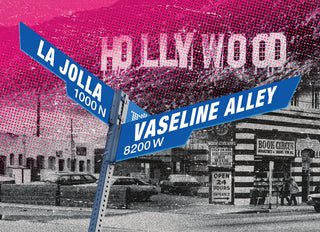Perhaps most ironic, viewed from today's perspective of intersectionality, is how extensively, especially in the San Francisco images, the "hippie" background dovetails with, for example, the vibrant flamboyance of many of those in the Pride Parades. How many degrees of separation are there, really, between Ken Kesey's Merry Pranksters and The Sisters of Perpetual Indulgence?
As they stand, these historic images are time capsules of a few places in America, where, for the very first time, and for a very short while, it was okay to be gay.
Contributor Bio:Blair, Nicholas
Nicholas Blair dropped out of high school in 1974 and left his native New York City to hitchhike through Latin America.
Landing in San Francisco a year later, he helped found The Modern Lovers arts commune and Ancient Currents Gallery, both dedicated to cultural exploration. In 1981, he received his MFA in photography from the San Francisco Art Institute under the tutelage of renowned photographer and teacher Henry "Hank" Wessel.
Blair has worked internationally as a photographer and cinematographer for organizations including CARE and the United Nations. His filmmaking projects include the documentary America's Culture of Crash about the rural American sport of demolition derby, and Our Holocaust Vacation, a journey through Poland with his mother and family, revisiting her Holocaust experiences there.
He has received fellowships from the National Endowment for the Arts, New York Foundation for the Arts, and Jerome Foundation. His photographs are in the collections of the Metropolitan Museum of Art, International Center of Photography, Brooklyn Museum, and Bibliothèque Nationale in Paris.
Contributor Bio:Farber, Jim
Jim Farber is a regular contributor to the New York Times, the Guardian, and numerous other publications. For 25 years he was the chief music critic of the New York Daily News and has been writing about culture since the 1970s. He is a three-time winner of the ASCA
Perhaps most ironic, viewed from today's perspective of intersectionality, is how extensively, especially in the San Francisco images, the "hippie" background dovetails with, for example, the vibrant flamboyance of many of those in the Pride Parades. How many degrees of separation are there, really, between Ken Kesey's Merry Pranksters and The Sisters of Perpetual Indulgence?
As they stand, these historic images are time capsules of a few places in America, where, for the very first time, and for a very short while, it was okay to be gay.
Contributor Bio:Blair, Nicholas
Nicholas Blair dropped out of high school in 1974 and left his native New York City to hitchhike through Latin America.
Landing in San Francisco a year later, he helped found The Modern Lovers arts commune and Ancient Currents Gallery, both dedicated to cultural exploration. In 1981, he received his MFA in photography from the San Francisco Art Institute under the tutelage of renowned photographer and teacher Henry "Hank" Wessel.
Blair has worked internationally as a photographer and cinematographer for organizations including CARE and the United Nations. His filmmaking projects include the documentary America's Culture of Crash about the rural American sport of demolition derby, and Our Holocaust Vacation, a journey through Poland with his mother and family, revisiting her Holocaust experiences there.
He has received fellowships from the National Endowment for the Arts, New York Foundation for the Arts, and Jerome Foundation. His photographs are in the collections of the Metropolitan Museum of Art, International Center of Photography, Brooklyn Museum, and Bibliothèque Nationale in Paris.
Contributor Bio:Farber, Jim
Jim Farber is a regular contributor to the New York Times, the Guardian, and numerous other publications. For 25 years he was the chief music critic of the New York Daily News and has been writing about culture since the 1970s. He is a three-time winner of the ASCA












